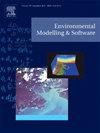More than modelling: Building trust for positive change in water resources management
IF 4.8
2区 环境科学与生态学
Q1 COMPUTER SCIENCE, INTERDISCIPLINARY APPLICATIONS
引用次数: 0
Abstract
Hydrologic modelling plays a vital role in water resources management but often falls short of achieving the positive change modelers envision. In this position paper we argue that a key contributing factor is the lack of trust and shared understanding among modelers, decision-makers, and the public. Models need to be trusted first—a social challenge as well as a technical one. Through three case studies—involving groundwater development, a national-scale runoff model, and a declining lake ecosystem—we analyze the interactions between technical modelling, stakeholder engagement, and policy outcomes, drawing on principles from both hydrologic and social sciences. We recommend that hydrologic modelers foster transparency, balance model authority with flexibility, and tailor stakeholder engagement to overall project needs. Implementing these recommendations will enhance the legitimacy of hydrologic models, increasing the likelihood of achieving positive, sustainable change in water resource systems.
不仅仅是建模:为水资源管理的积极变化建立信任
水文建模在水资源管理中发挥着至关重要的作用,但往往无法实现建模者所设想的积极变化。在这一立场文件中,我们认为一个关键的促成因素是缺乏信任和共同理解之间的建模,决策者,和公众。模型首先需要被信任——这既是一项社会挑战,也是一项技术挑战。通过三个案例研究——涉及地下水开发、全国范围的径流模型和湖泊生态系统的衰退——我们分析了技术建模、利益相关者参与和政策结果之间的相互作用,并借鉴了水文学和社会科学的原则。我们建议水文建模师提高透明度,平衡模型的权威和灵活性,并根据整个项目的需要调整利益相关者的参与。实施这些建议将提高水文模型的合法性,增加在水资源系统中实现积极、可持续变化的可能性。
本文章由计算机程序翻译,如有差异,请以英文原文为准。
求助全文
约1分钟内获得全文
求助全文
来源期刊

Environmental Modelling & Software
工程技术-工程:环境
CiteScore
9.30
自引率
8.20%
发文量
241
审稿时长
60 days
期刊介绍:
Environmental Modelling & Software publishes contributions, in the form of research articles, reviews and short communications, on recent advances in environmental modelling and/or software. The aim is to improve our capacity to represent, understand, predict or manage the behaviour of environmental systems at all practical scales, and to communicate those improvements to a wide scientific and professional audience.
 求助内容:
求助内容: 应助结果提醒方式:
应助结果提醒方式:


